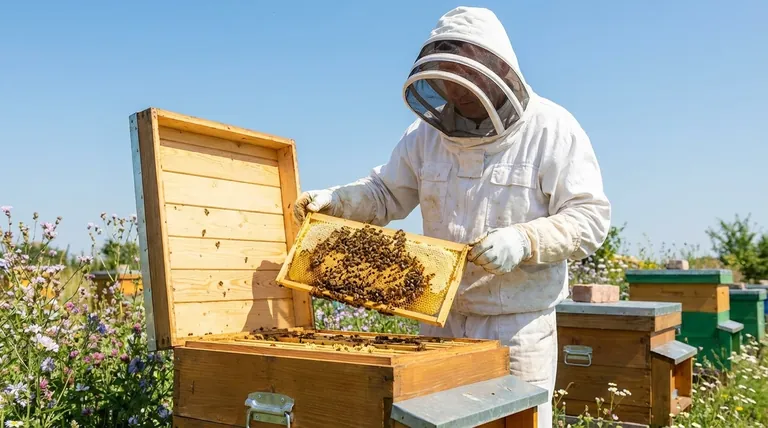The ideal time to inspect a beehive is on a warm, clear, and calm day, typically between 11 AM and 3 PM. During this window, the sun provides optimal light for seeing eggs and larvae, and a significant portion of the older, more defensive forager bees are out of the hive, leaving a calmer colony for you to work with.
The core principle is not about a specific time on the clock, but about aligning your work with the bees' natural daily rhythm. A successful inspection minimizes stress on the colony and maximizes safety and visibility for the beekeeper.

The Principles of Optimal Hive Inspection
Understanding why a certain time is best empowers you to make the right call even when conditions aren't perfect. The goal is always to work with the bees, not against them.
Aligning with the Foragers' Schedule
The workforce of the hive is divided by age. The older, more experienced bees become foragers, and they also tend to be the most defensive.
By inspecting during midday on a sunny day, you are working when the maximum number of these foragers are out collecting nectar and pollen. This leaves the hive populated primarily by younger, more docile nurse bees, significantly reducing the defensiveness of the colony.
Optimizing for Weather Conditions
Bees are highly sensitive to their environment. Their mood and behavior are directly tied to the weather.
The ideal conditions are warm (above 60°F / 15°C), sunny, and with minimal wind. Cool or rainy weather keeps all the bees inside, creating a crowded and irritable colony that is far more likely to be defensive.
Ensuring Maximum Visibility
A primary goal of any inspection is to assess the health of the queen by spotting her eggs. Bee eggs are tiny, resembling a small grain of rice at the bottom of a cell.
The high, direct sunlight of midday is essential for illuminating the deep cells of the comb, making it possible to see these critical signs of a healthy, laying queen. Trying to inspect in the shadows of early morning or late evening makes this crucial task nearly impossible.
Common Pitfalls: When to Avoid Inspections
Knowing when not to open a hive is just as important as knowing when to do it. Disturbing the colony at the wrong time can cause unnecessary stress and put the bees' health at risk.
During Poor Weather
Never inspect a hive on a rainy, cold, or highly windy day. Opening the hive in these conditions can severely chill the developing brood, potentially killing them. The bees will also be understandably agitated and highly defensive.
Too Early or Too Late in the Day
Inspecting in the early morning or near dusk is a common mistake. At these times, all the foragers have returned home, leading to a crowded hive that is much more difficult and hazardous to manage.
Immediately After Installation
When you first install a new package or nuc, give the bees time to adjust. A good rule is to wait at least three to five days before performing your first quick inspection. This allows them to settle, orient themselves, and begin their work without immediate disruption.
Making the Right Choice for Your Goal
Your approach should be guided by your specific objective. While the "midday rule" is the standard, your reason for opening the hive matters.
- If your primary focus is a routine health check: Strictly adhere to inspecting on a warm, sunny, calm day between late morning and mid-afternoon for the best experience.
- If you are performing a quick task like adding a super or feeder: You have slightly more flexibility, but calm and warm conditions are still strongly recommended.
- If you are responding to an emergency (like a suspected predator): You may need to act outside of ideal hours, but do so quickly, calmly, and with proper protective gear.
Ultimately, successful beekeeping is about observing your bees and working in harmony with their natural cycles.
Summary Table:
| Key Factor | Ideal Condition | Why It Matters |
|---|---|---|
| Time of Day | 11 AM - 3 PM | Most foragers are out, leaving a calmer colony. |
| Weather | Warm (>60°F / 15°C), sunny, calm | Bees are less defensive; brood is protected from chill. |
| Visibility | Bright, direct sunlight | Essential for spotting tiny eggs and assessing queen health. |
| When to Avoid | Early morning, dusk, cold/rainy/windy days | All bees are home; colony is crowded and defensive. |
Equip your apiary for success with HONESTBEE.
Performing hive inspections is a fundamental skill, and having the right, durable equipment makes all the difference. Whether you manage a commercial apiary or are a beekeeping equipment distributor, HONESTBEE supplies the high-quality, wholesale-focused supplies you need to work efficiently and safely.
We provide everything from durable bee suits and reliable smokers to essential hive tools, helping you and your bees thrive.
Ready to stock up on professional-grade beekeeping supplies? Contact our wholesale team today to discuss your needs and get a quote.
Visual Guide

Related Products
- Langstroth Bee Hives Bee Keeping Box for Beginners Beekeeping
- Australian Langstroth Beehive Boxes for Beekeeping Wholesales
- Langstroth Honey Bee Box Hive Boxes for Different Depths
- HONESTBEE Professional Long Handled Hive Tool with Precision Cutting Blade
- Professional Insulated Plastic Bee Hives
People Also Ask
- Why might a beginner be advised to start with a Langstroth hive? Unlock a Supportive Beekeeping Ecosystem
- Why were wooden hives traditionally preferred? For Natural Beekeeping Aligned with Bee Biology
- What are the different types of beehive boxes available? Choose the Right Hive for Your Apiary
- Should a beginner try a different type of hive? Start with a Langstroth for a solid foundation.
- How does the orientation of the hive sides benefit comb construction? Ensure Straight, Movable Combs for Easier Hive Management



















